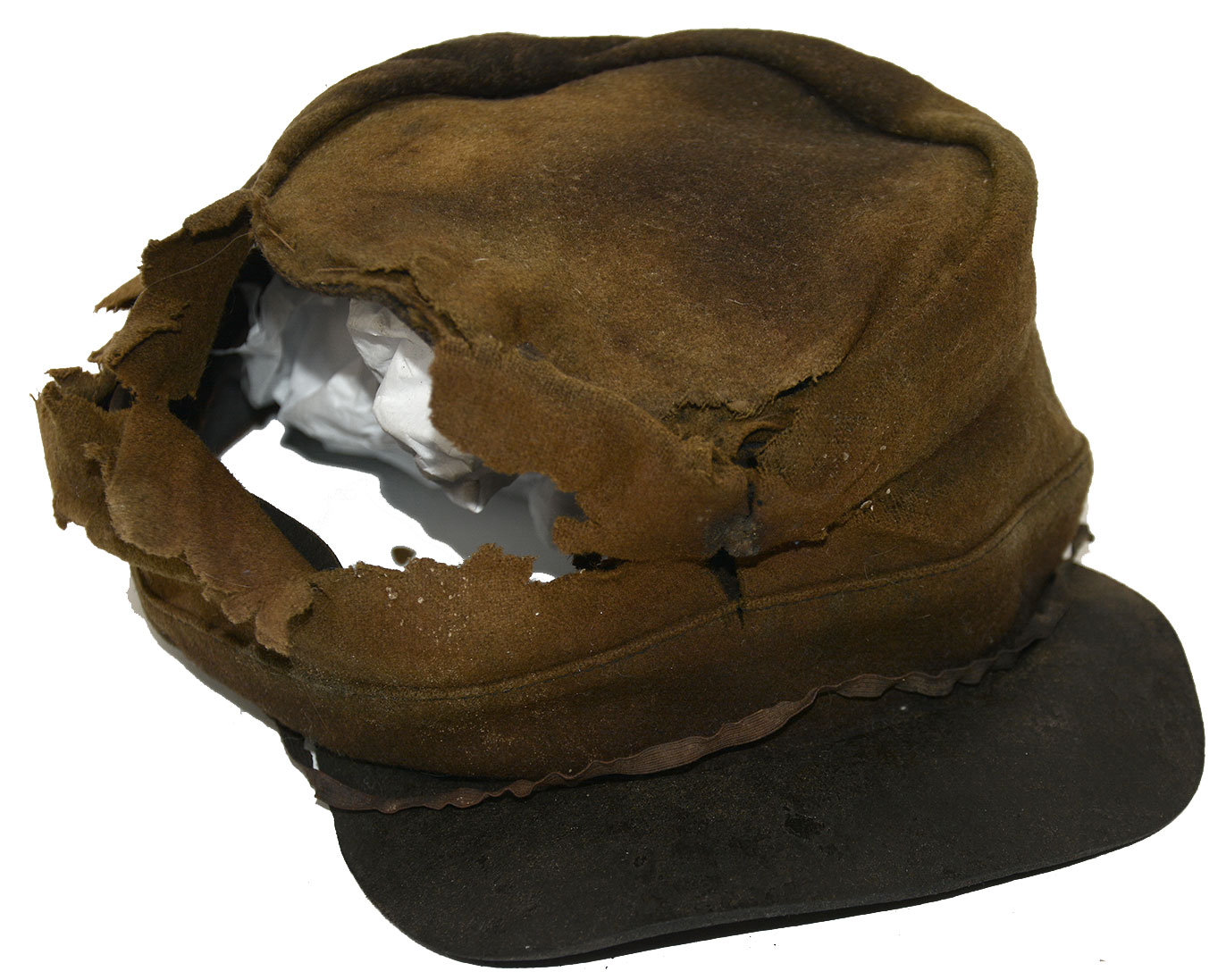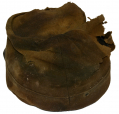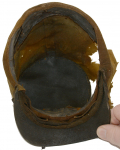site search
online catalog
REGULAR ARMY CIVIL WAR ENLISTED KEPI WITH INDIAN WAR USE FROM FORT PEMBINA, NORTH DAKOTA

$1,695.00
Quantity Available: 1
Item Code: 1052-247
Shipping: Determined by Method & Location of buyer
To Order:
Call 717-334-0347,
Fax 717-334-5016, or E-mail
This Civil War enlisted man’s kepi comes from the excavations at Fort Pembina, ND, conducted on private property with the owner’s permission. The fort was established in 1870 by troops of the 20th US Infantry and as is typical of the early Indian Wars regular army, their issue uniforms and gear were wartime surplus and even a privately purchased cap like this might be a hold-over from wartime service or a retailer’s inventory. The cap has the typical inset crown of the kepi form, with the front rising about 3” from the top of the visor, along the lines of the “McClellan” style cap and has 1” band around the base. There is no lining left, but most of the sweatband and the leather stiffener inside the crown are in place. The visor has a raw edge, not bound, is about 1 3/8” deep at center, and slightly curved. No chinstrap remains, but there is a narrow ribbon running across the top of the visor from side to side that may have been elastic and served to keep the cap in place with or without a chinstrap.
The cap retains its form. The fabric remains fairly supple and has shifted in color to a light brown with a few darker areas. The (wearer’s) right side has a large hole along the upper portion running back to the middle of the right, with a small secondary hole and tear below that and just to the rear. The front has a small tear at top and a slight seam separation. (The circular inset top is all there.) There are two, narrow, short slits on the left rear.
These kepis became popular starting about the middle of the war and are sometimes termed the “McClellan” style, from that general’s preference for them. Though more compact in form than the issue Model 1858 fatigue cap, they were still roomier than the “chasseur” style that became the Model 1872 fatigue cap and could be a comfortable alternative to that issue cap.
Any Civil War or even Indian War regular army cap is scarce. There are tons of the M1872 forage caps out there, for instance, but the vast majority are national guard, fraternal, or G.A.R. caps. Finding a cap actually used on the western frontier is a very different matter.
Fort Pembina, situated in the Red River Valley in North Dakota near the Canadian border, was established in 1870 and in operation until 1895. Trading posts existed earlier in the area as part of the fur trade, and the first U.S. military post there was temporary- manned by a detachment of Minnesota troops in 1863-1864 following the 1862 Sioux uprising. In March 1870 a new fort was established south of the Pembina River and about 200 yards west of the Red River, completed by July and named in honor of Gen. George H. Thomas. The name was changed to Fort Pembina in September and the initial garrison consisted of two companies of the 20th US Infantry. Their main purpose was to provide security for settlers worried about Sioux returning south from Canada, but the troops spent much of their time escorting boundary surveys along the Canadian border and preventing Fenian raids heading north into Canada.
The fort included enlistedmen’s barracks, officers’ quarters, guard house, ordnance storehouse, company kitchen, root house, laundress’s quarters, quarters for civilian employees, hospital and hospital servant’s house, a barn for the “hospital cow,” quartermaster and commissary offices and storehouse, stables, wagon shed, etc. The garrison reached peak strength in 1878 af 200, but the average was about 125 enlisted men and 8 officers. An October 1885 return listed 97 men, 2 field pieces, 1 mountain howitzer, 100 rifles, 19 pistols, 23 mules, and 9 wagons. By 1890 the post had just 23 men, and after an 1895 fire destroyed some 19 buildings it was decided to abandon the fort rather than rebuild, the last detachment left in September. The property was turned over to the Interior Department and later sold in 1902.
This is a scarce relic, actually worn at a small frontier fort. [sr][ph:L]
~~~~~~~~~~~~~~~~~~~~~~~~~~~~~~~~~~~
THIS ITEM, AS WITH ALL OTHER ITEMS AVAILABLE ON OUR WEB SITE,
MAY BE PURCHASED THROUGH OUR LAYAWAY PROGRAM.
CLICK HERE FOR OUR POLICIES AND TERMS.
THANK YOU!
Inquire About REGULAR ARMY CIVIL WAR ENLISTED KEPI WITH INDIAN WAR USE FROM FORT PEMBINA, NORTH DAKOTA
For inquiries, please email us at [email protected]
Most Popular
Historical Firearms Stolen From The National Civil War Museum In Harrisburg, Pa »
Theft From Gravesite Of Gen. John Reynolds »
Cavalry Carbine Sling Swivel »
Fine Condition Brass Infantry Bugle Insignia »
featured item
OFFICER’S FROCK COAT OF BREVET MAJOR GENERAL JOSEPH K. BARNES, SURGEON GENERAL OF THE U.S. ARMY 1864-1882
This would be the centerpiece of any medical collection: the Major General’s frock coat of Surgeon General Joseph K. Barnes. Barnes was born in Philadelphia in 1817, studied medicine at Harvard, under US Navy Surgeon General Harris, and received… (1179-579). Learn More »








